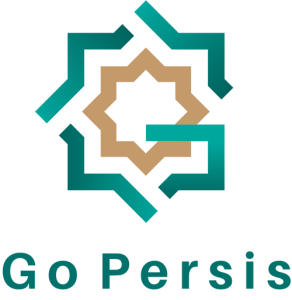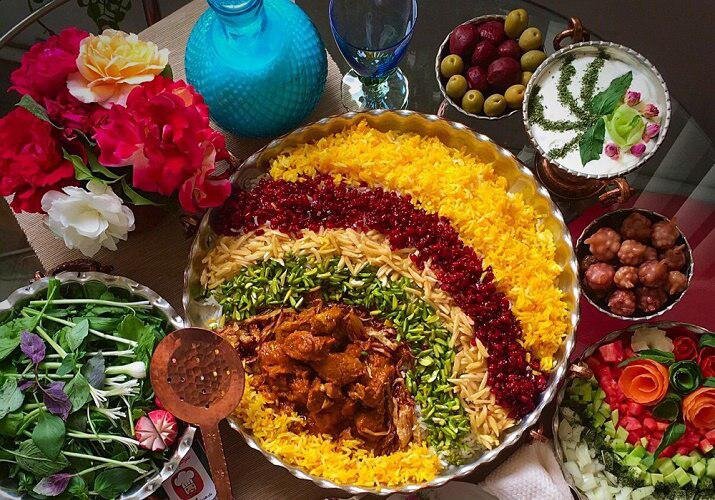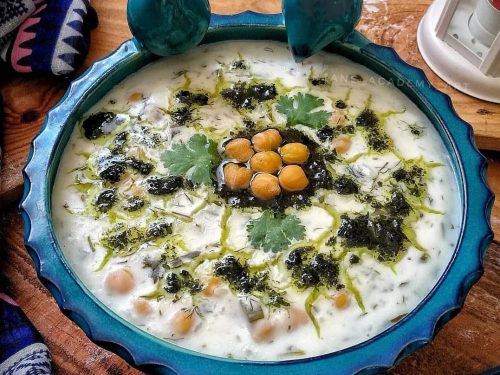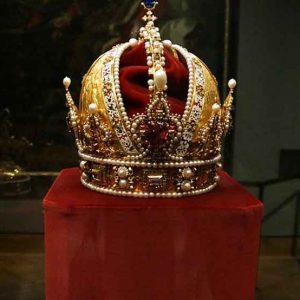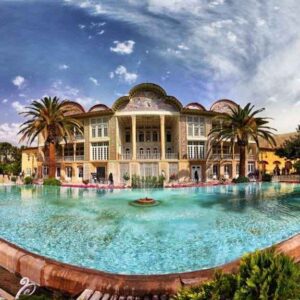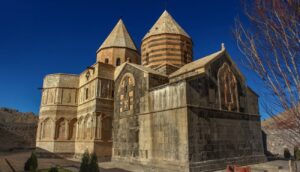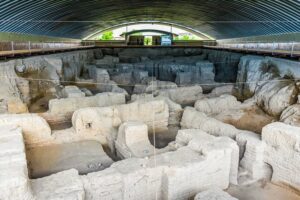Persian Food Tour Destinations
Persian Food Tour Itinerary
Tehran (3N), Qazvin (2N), Rasht (2N), Ardabil (2N), Tabriz (2N), Zanjan (1N), Kurdistan (2N), Kermanshah (2N), Shiraz (2N), Isfahan (3N), Kashan (1N).
Day 1: Tehran, Persian Food Tour Gate
On the time of arrival at IKA Airport, Persian Food tour guide will welcome you with a Logo show card. They will guide you to exit the airport to the hotel. Let’s leave the pressure of flight under the shower and relax before visiting Tehran Treasures. Tehran is the most modern city and capital of Iran. It shows the traditional and contemporary combination of Persian culture. Alborz mountain range covers the north area of Tehran. Also, Tehran narrates Persian food history as it is multicultural capital. It embraces cultural & natural landscapes with the brilliant glory of palaces and incredible museums.
(Today’s Persian Food Tour plan depends on the time of arrival). Before Check-in, we visit Azadi Tower. It is a symbol of modern Tehran and the contemporary national gate of Iran. After that, we walk through Laleh Park to the Carpet Museum. It shines for the collection of Persian carpets from 1500 years ago to now. Soon after, we reach Contemporary Art Museum to indulge ourselves to expand our knowledge about Persian Modern Arts. Also, there is the most valuable collection of Western art out of Europe and America. Finally, we will gather together to have a brief about the Persian Food Tour.
Overnight Tehran, (D).
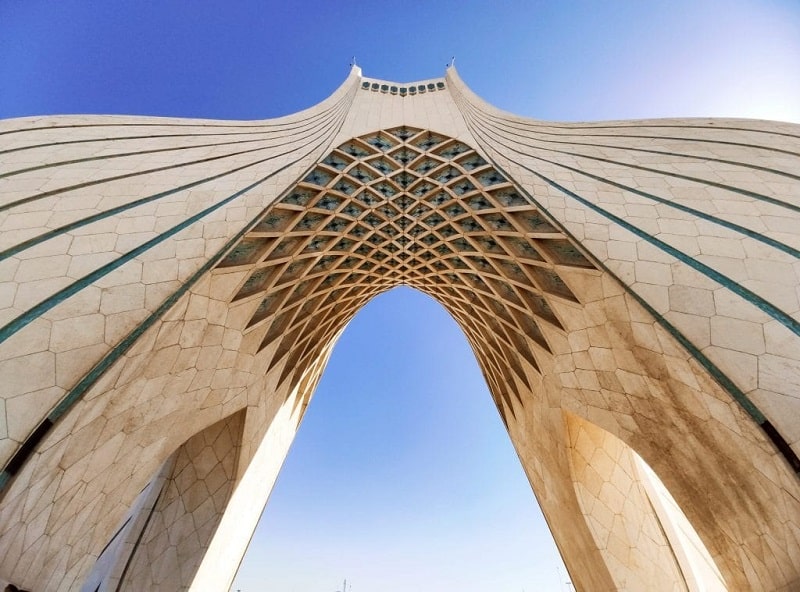 Azadi Tower is a contemporary architectural masterpiece with an ancient Sassanid style. It connects history with the modern era in Tehran.
Azadi Tower is a contemporary architectural masterpiece with an ancient Sassanid style. It connects history with the modern era in Tehran.
Day 2: Tehran, Bazaar to Table Persian Food
Today, we begin with Sa’ad Abad Complex near Darband Persian food street spot. Sa’ad Abad is at the footage of the Alborz mountain range with a very pleasant climate. It proves itself as a royal residence for two dynasties from Qajar to Pahlavi. Sa’ad Abad Palace embraces palaces, museums, and galleries that depict Persia’s contemporary era in detail. Then, we feel spirituality in Tehran’s holiest shrine (Imamzadeh Saleh) in Tajrish. Imamzadeh Saleh is so close to the old Tajrish Bazaar. The bazaar is home to fresh ingredients, fruits, herbs and Persian food.
The Bazaar gives knowledge about the traditional style of Iranian daily life. Also, we explore the Tajrish bazaar to experience old shops filled with herbs and flavourings. Although, we see how Iranians take fresh ingredients to cook Persian recipes. Those fresh ingredients help mothers cook popular Persian meals for families. Now, it’s time to join a cookery workshop close to Tajrish Bazaar. The workshop let us know about Iranian cuisine and taste delicious Persian food.
Overnight Tehran, (B, L, D).
 Tajrish Bazaar is a very distinctive local bazaar in the northern part of the capital. It shows a traditional Iranian Bazaar with a very attractive vegetable spot.
Tajrish Bazaar is a very distinctive local bazaar in the northern part of the capital. It shows a traditional Iranian Bazaar with a very attractive vegetable spot.
Day 3: Tehran, Capital of Iranian Street Food
The historical region of Tehran starts with Golestan Palace a royal complex over 400 years old. Golestan Palace embraces peculiar ornaments such as tiling, mirror-works and paintings. It surpassed the four kings who crowned in its majesty and now distinguished itself as a UNESCO World Heritage. After the palace, we take a walk to overlook Tehran Grand Bazaar. Tehran Bazaar is home to delicious traditional Persian food as a roofed-up building with old-time architecture. The special passages and pathways invite travelers to food ingredients, herbs and flavorings. Tehran bazaar host great Iranian restaurants such as Moslem restaurant that serve tasty Persian foods.
After that, (Sat to Tue 14:30 to 16:30) walking to the Treasury of National Museum (National Jewelry Museum). The museum shines on the beauty of the diamonds, jewels and illustrious royal heritages. In the evening, (if National Jewelry Museum wasn’t open) we keep travelling deep into Persia by visiting Iran National Museum. It holds archaeological collections in two separate structures; the Ancient Iran Museum and the Museum of the Islamic Period.
Today, the Persian Food Tour serves you mouthwatering Persian dishes close to the historical region of Tehran. You smell the most popular restaurants with their unique Persian food menu. Persian meals mainly include different kinds of Kebabs, especially Kobideh. Also, Iranian cuisine embraces stews such as Qormeh-sabzi. Better, we take a walk in the central region of Tehran to reach the famous Persian food Street. Si-e-Tir Street attracts all attention to the unique tasty atmosphere of Iranian food culture.
Overnight Tehran, (B, L, D).
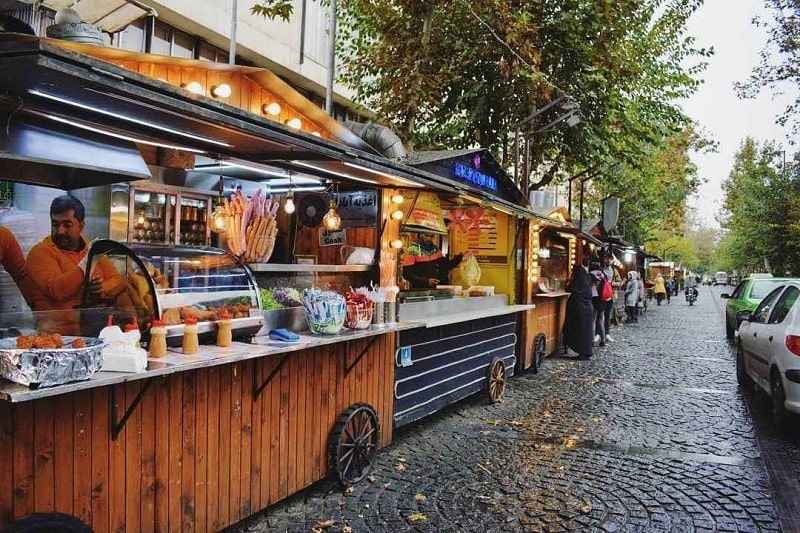
Day 4: Tehran-Qazvin, Heart of Persian Cuisine
Qazvin, a city with 9000 years of civilization lies on the way of the Silk Road. Qazvin’s history proves its significance to be the capital of the country in different periods. Alamut Castle is the prominent legacy of the city besides Saad al-Saltaneh Caravanserai. Qazvin embraces rice-based Persian food and incredible grapes gardens.
Persian food Tour starts with the Chehel Sotun Pavilion that goes to the reign of the Safavid Dynasty. Qajar Dynasty reconstructed the building and now it is a Calligraphy museum. After that, we take a walk to the Four Prophet Mausoleum. It belongs to four Jewish prophets. They had a message about Jesus Christ’s birth to the East. The structure is a decoration of stucco relief and Quranic inscription. Then, walk to Safavid Garden & Complex a historical area with edifices from the Safavid dynasty, Afsharid, and Qajar.
Qazvin is a city close to the rice cultivation regions in the northern part of Iran. Safavid kings used to govern the country from Qazvin with their special rice-based Iranian cuisine. Royal food mostly included rice and beef during Safavid Dynasty. Qazvin is not only popular as the Persian Food Capital but for the cooking art of Iranian traditional food. Good to say that, jeweled rice meals such as Morasa Polow and Qeimeh Nesar are the gastronomy heritage of Qazvin. So, experiencing colorful garnished rice dishes energizes us to join the culinary workshop. We see how locals cook, flavour and color these Persian recipes. Although, we learn how to play with herbs, fruits, flavorings, and Saffron to cook Iranian food in a traditional house.
Overnight Qazvin, (B, L, D)
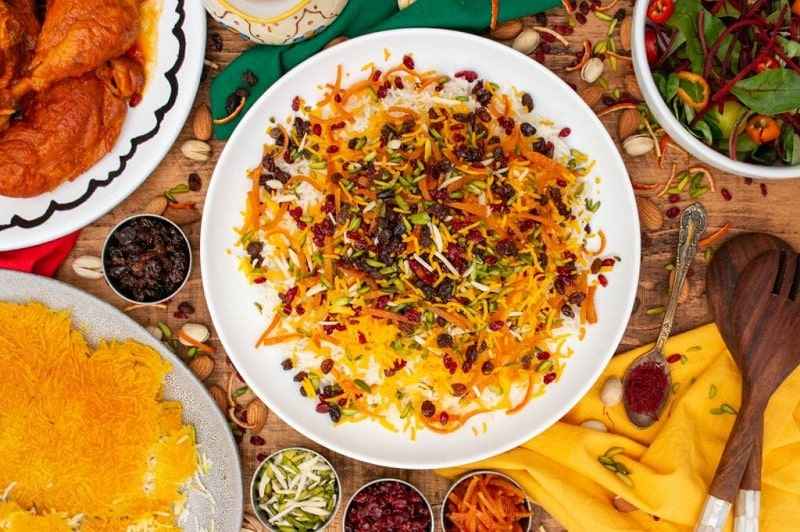
Day 5: Qazvin, Grape Gastronomy and Vinegar in Persian food
Today, we start the Persian Food Tour by walking to the best-preserved caravanserai in Iran. Saad al-Saltaneh Caravanserai is the largest urban one of its kind. The architecture consists of Iwan, Hojre (Travelers room), Dome and courtyards. The caravanserai provides a relaxing atmosphere for travellers and traders. There are great cafes and restaurants to taste Persian food and Sherbat (drinks). Soon after, we visit Cantor Church, a Russian Orthodox Church that Russian engineers built in Iran around 100 years ago. After that, we visit Qajar Bathhouse, a famous kind of Persian bath for gathering and bathing.
Qazvin is one of the most important grape centers in Iran. locals produce grape sour juice, raisins and grape drinks. Also, the most important product out of those gardens is vinegar. Iranian chefs mostly use vinegar in culinary art as an acidic and flavorful ingredient. Thought, we join a local class to learn the costumes and traditions of vinegar production (Season-based workshop). Then, the Persian Food Tour takes tourists to another workshop which demonstrates one of the incredible Persian special dining experiences. We learn cooking techniques to have better details about the province’s culinary art and Qeyme-near.
Overnight Qazvin, (B, L, D).
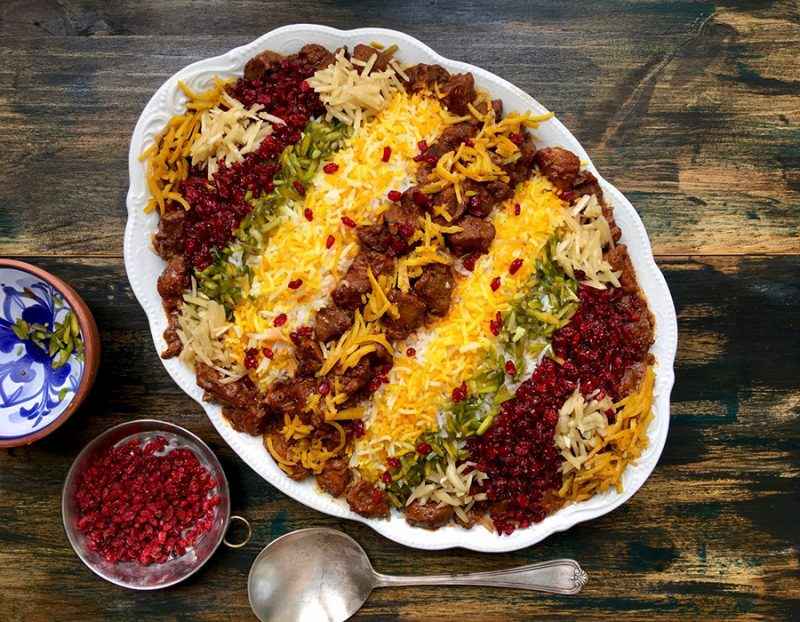 Qeyme-nesa is a special kind of Qeyme in Qazvin. Its ingredients are rice, almonds, and fried onions that chefs garnish with barberry and saffron.
Qeyme-nesa is a special kind of Qeyme in Qazvin. Its ingredients are rice, almonds, and fried onions that chefs garnish with barberry and saffron.
Day 6: Qazvin-Gilan, Persian Food UNESCO Creative City
Gilan the capital of Iran gastronomy art lies alongside the Caspian Sea. The city embraces Hyrcanian forests as a UNESCO World Heritage Site. The forests date back to 42-50 million years ago and influenced Gilaki cuisine so much. Gilan plays an important role in shaping Persian food culture regarding the production of home-gardens vegetables, rice, and fresh ingredients. Also, the UNESCO Creative City of Persian Food is the homeland of rich customary beliefs and social forms. Gilan narrates incredible culture such as language, gastronomy, music, clothes, and rural lifestyle.
Persian Food Tour passes through Rodbar and Manjil counties to reach Gilan. Those counties are the olive production center of Iran. So, we will have the opportunity to have a farm-to-table experience. Those counties’ olive cultivation and nurturing have a great taste in Persian food culture. Also, the Gilan majority population lives in rural areas in distinctive dwellings. Resuming that, Gilan plays an important role in the safeguarding of rural Persian cuisine.
Persian Rural and Mountain Cuisine
The Persian Food Tour takes an excursion to Gilan Rural Heritage Museum to depict the rural lifestyle. The museum gives a better understanding of Iranian village cuisine and recipes alongside Hyrcanian Forests. Also, we take a cooking class for Gilaki gourmet food in natural scenery. The workshop is close to the Rural Heritage Museum to feel the atmosphere of Persian cookery art in rural shelters. Then, our Persian Food Tour continues with a visit to a tea wetland farm and factory. It lets us experience the customs of English Tea production in Iran.
Finally, we move towards Masouleh village which is a characteristic settlement in Foman county. Masouleh shows extraordinary architectural beauty. Houses lie ahead in the brown exterior design including woody windows. Locals decorate windows with flowerpots which are full of colorful blossoms. Masouleh village proves distinctive architecture. The courtyard of a house is the roof of another. As well, locals cook tasty Gilaki food such as Baghalighatoq with fresh ingredients and additives. Food garnishing is a great heritage of Gilan and its villages in Persian food culture.
Overnight Masouleh, (B, L, D).
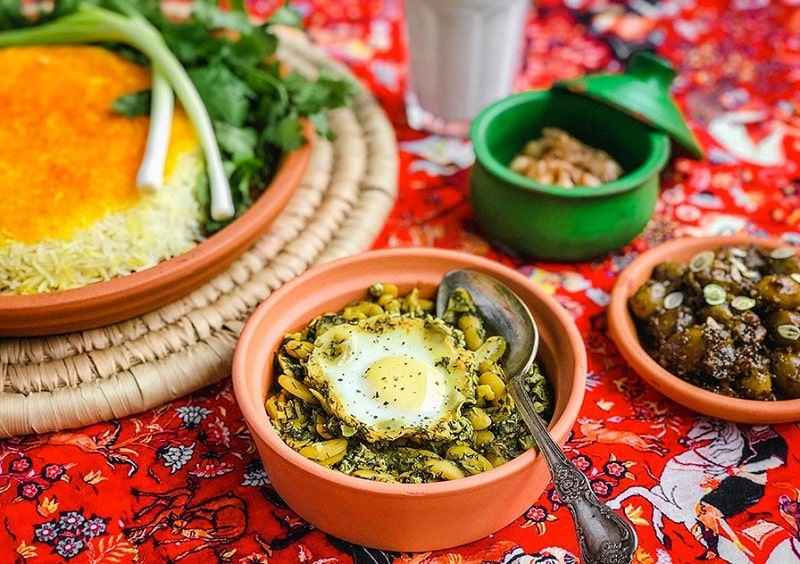 Baghali ghatogh is a Gilaki recipe that Gilaki people serve with Kateh (rice dish). Gilaki garnishes Kateh with the stew that contains favs beans, egg and dill. People flavor this Persian Food with garlic and pepper.
Baghali ghatogh is a Gilaki recipe that Gilaki people serve with Kateh (rice dish). Gilaki garnishes Kateh with the stew that contains favs beans, egg and dill. People flavor this Persian Food with garlic and pepper.
Day 7: Masouleh, Rural Persian Food Experience
Today, Persian Food Tour devotes itself to Gilaki culinary art and the natural sceneries of the Masouleh environment. The mountain gastronomic taste is a responsive lifestyle to nature and rural areas. In addition, we taste Persian mountain cuisine and diary local classes. Those workshops help us discover more about Gilaki dishes such as Sour Chicken, Sour Kebabs and Mirza-ghasemi. Though, Iranian recipes contain herbs, cheese, fresh additives, and fork-to-table fruits here. Also, Masuleh embraces not only distinctive food menus but also shows unique clothes and folkloric customs and traditions.
Overnight Masouleh, (B, L, D).
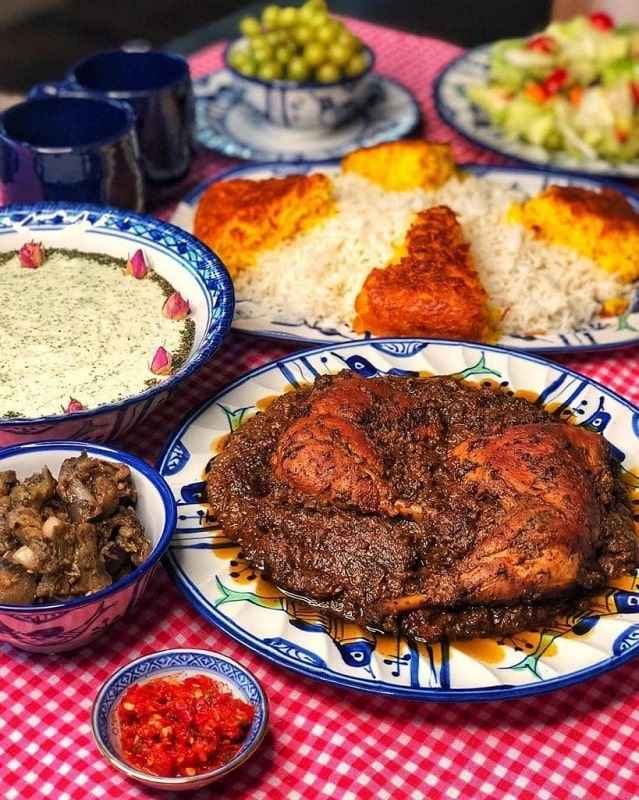 Sour Chicken is a spicy Gilaki food with additives such as pepper and saffron. Also, it contains walnut, and yoghurt to become well-grilled and taste sour.
Sour Chicken is a spicy Gilaki food with additives such as pepper and saffron. Also, it contains walnut, and yoghurt to become well-grilled and taste sour.
Day 8: Masouleh-Sarein, Land of Hot Springs and Honey
Sarein County lies alongside the Zagros Mountain Range. It embraces picturesque landscapes and unique Persian cuisine culture. The county is the land of natural hot springs with a calm atmosphere to have massage and spa baths. The Zagros brings us wellness and health by offering a fresh Persian food menu. Also, traditional and modern pools with diverse treatments bring great relaxation.
Better, we discover a kind of Azerbaijan nomadic hand-weave carpet on the way to Sarein. Good to know that, the Azeri people call it Jajim. It is a type of Persian Kilim in Ardabil. Jajim is a model of a colorful Persian rug that Azeri people make out of wool or silk. Azeri use it to wrap bedding as it is a half meter in length and twenty mm in width. Besides, the Persian Food Tour takes us to Sabalan preserving area. Sabalan is famous for its natural food and fruit products. Honey Qotab as a local snack tastes very different from what tourists expect. Then, we find out more about food sustainability in beehive farms. We touch the hard work of locals who produce honey. The Sabalan honey is a must in the Iranian breakfast and brunch menu.
Overnight Sarein, (B, L, D).
 Honey Qotab is a popular Azeri snack with rich ingredients such as honey, walnut, flour and cardamon. Azeri flavor Qottab with saffron and rosewater and eat it with tea as a Persian snack.[/caption]
Honey Qotab is a popular Azeri snack with rich ingredients such as honey, walnut, flour and cardamon. Azeri flavor Qottab with saffron and rosewater and eat it with tea as a Persian snack.[/caption]
Day 9: Sarein-Ardabil, Persian Food Butchery and Beef Gastronomy Art
Ardabil is the motherland of Sheikh Safi-ad-din, who is the founder of the Safavieh order. The orders shaped the root of the Safavid Dynasty ideology. Also, the city is rich in Persian food and culinary heritage and spiritual evidence. Ardabil established its brand for hot springs, natural landscapes, and Persian food heritage. Besides, for fresh fruits, nuts, sweets, cuisine, snacks, and handicrafts, especially silk carpets and rugs.
Today, the Persian Food Tour devotes itself to Safavid Dynasty heritage. We start by visiting Safi-ad-din Ardabili Tomb (UNESCO Heritage). Sheikh is Murshid of Sufism and his beliefs and ideologies created Safavid credence in Persia. The Complex includes a Khanghah, a Mosque and a courtyard. Besides, we experience Persian butchery in a land of livestock. Beef plays a very important role in Persian food culture. It means that most Iranian cuisine includes beef in its recipes. Also, Iranians barbecue kebabs as the most important beef-based Iranian food.
Though, Ardabil dedicates thousands of hectares to cows & sheep to graze for meat and dairy production. Then, we enjoy the most traditional Persian food that Iranian call Dizi. Dizi includes meat, beans, tomatoes, and spices such as pepper and salt. Iranian eat Dizi with Sangak bread for lunch to enjoy traditional Persian food mostly on Fridays.
Overnight Sarein, (B, L, D)
Dizi is the most traditional Persian food with tasty stories behind. It is a historical rural cuisine that farmers cook. They build fires and stirring meat, tomatoes, and beans with salt and pepper.
Day 10: Sarein-Tabriz, Capital of Traditional Azeri and Persian Food
Tabriz is the most significant region in the historic Azerbaijan area of Iran. It plays an important role in Persian cuisine, culture, industry, modernity and handicrafts. Also, fork-to-table food culture plays an important role in the city. Tabriz embraces a great heritage of Persian food with a tasty combination of Azeri cuisine. The city monuments and popular food prove the culture, customs and traditions of royal families. Also, Tabriz is a World Carpet Weaving City by UNESCO.
Persian Food Tour today’s exploration include the natural sceneries of Sabalan inactive volcanic peak. Nature amazes us with green lands and picturesque views of mountains and valleys. Also, fruit gardens shine like a diamond on the way to Tabriz. We learn more about Persian original fruits and how locals dry, cook and preserve them. As well, Persian cuisine knows the use of dried fruits in cooking art well. Tabriz is home to Azeri gastronomy in the north part of Iran with diverse cookery arts. They cook different kinds of meat-vegetable combinations such as Kufta or Dolma. Also, they bake various types of bread such as Barbari. Then, we reach El Goli Garden which shines with a large artificial pond and a mansion.
Overnight Tabriz, (B, L, D).
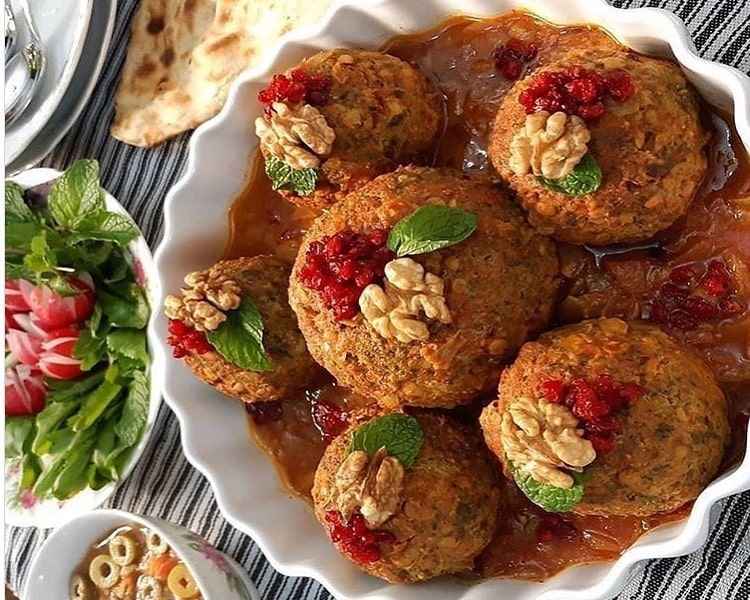 Kufta Tabrizi could be an incredible representative of Tabriz’s food art. It is a combination of vegetables, nuts, and rice. Kufta tastes sour or spicy as a main dish.
Kufta Tabrizi could be an incredible representative of Tabriz’s food art. It is a combination of vegetables, nuts, and rice. Kufta tastes sour or spicy as a main dish.
Day 11: Tabriz, Azeri Gastronomy Heritage in Persian Cuisine
The Persian Food Tour exploration continues with Kandovan village. Locals built their cone-shaped homes on volcanic rocks. It verifies human integration with wild nature on the hillside of Sahand Mountain. The unbelievable village lifestyle in cave-like houses amazes visitors with identifying architecture.
Let’s Purchase handicrafts in local settlements to experience the alive Kandovan lifestyle. Walk through the rocky pathways to enjoy the mesmerizing environment of the Kandovan village. Now, it’s the time to taste an Azeri Ashe Doogh in a local class during touching on the rural lifestyle. Also, Kandovan’s confectionary art shows itself in Nogha. The gastronomy art proves Azeri heritage in Persian food arts in the northwest part of Iran.
Then, we wander at Tabriz Grand Bazaar (UNESCO Heritage) with its spectacular structure. The bazaar includes many sub-bazaars, as the largest roofed one in the world. Tabriz Grand Bazaar proves itself as a cultural, economic, and political center of the city. It is a hub for finding Persian food ingredients, herbs, nuts, and additives. Tabriz is not only a hub for Iranian food but also snacks such as Baklava. Also, there are famous restaurants that serve a great combination of Azeri and Persian food. They offer mouthwatering starters and desserts that Azeri garnish with fruits and nuts. Tabriz food shines like a diamond in Persian cuisine culture.
Overnight Tabriz, (B, L, D).
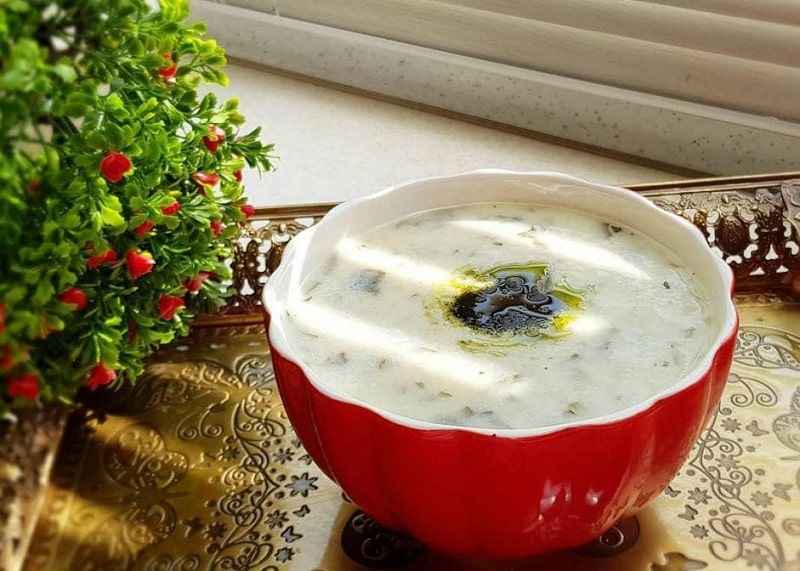 Ashe dogh is a unique Azeri food which looks like soup. It tastes heavier as Azeri cook it out of meat, beans, vegetables and yoghurt. Azeri people flavor it with herbs and spices such as salt.
Ashe dogh is a unique Azeri food which looks like soup. It tastes heavier as Azeri cook it out of meat, beans, vegetables and yoghurt. Azeri people flavor it with herbs and spices such as salt.
Day 12: Tabriz-Zanjan, Route of UNESCO Handicrafts and Persian Food Utensil
Zanjan is a pre-historic region in the Azeri area of Iran. It is famous for its agricultural products and fresh food ingredients such as seedless grapes. Also, Zanjan handicrafts like Malileh (UNESCO Heritage) and Knives are worldwide. Zanjan embraces dreamy views of natural inland sceneries and colorful mountains. Persian food cuisines use so much of Zanjan’s organic ingredients for flourishing Iranian recipes.
Persian Food Tour continues with touching natural landscapes on the way to Zanjan. We visit Rakhtshooy Khaneh, where people washed their clothing in. Soon after, we experience Saltmen Museum which hosts six dead bodies from 2500 years ago. Then, we visit worldly known Zanjan knives. Those knives are famous for sharp blades, durable, and diverse models. Good to know, artistry works decorate the knives with sea shells, wood, and ivory handle.
Its the time to join a workshop to learn better about Malileh (filigree). Malileh is an intangible UNESCO world heritage. It looks like goldsmithing out of copper or silver creates a chain of stripes to make pieces of jewelry.
Finally, we discover how Iranians make traditional Persian utensils and tableware. They create those Persian food utensils out of copper, zinc, and cast iron. Since Persians believe that those mineral materials add healing features to foods. Though, they make such utensils to be more familiar with bio-knowledge.
Overnight Zanjan, (B, L, D).
Knife Making Handicraft.
Day 13: Zanjan-Kurdistan, Route of Persian Herbs and Beef
Kurdistan is a mountainous region full of rivers, waterfalls, and glaciers. Kurdish people mostly live in the present district of Kurdistan. Also, Kurdistan is the homeland of Aryans who migrated to the central plateau of Iran.
On the way to Kurdistan, we have an excursion to the Dome of Soltaniyeh. It is a well-known structure in terms of architecture and spirituality. Soltaniyeh Dome is the Tomb of Oljeitu that the Mongol Dynasty (Ilkhanid) built in Iran. The Dome of Soltaniyeh is the largest brick dome with 49 tons of weight. Also, the third one of its kind after Florence Cathedral and Hagia Sophia in the world. After that, we taste a rare kind of gum that Persians call Saqqez. Kurdish people extract it from a very special tree for its healing effects on body health. Finally, by reaching Kurdistan, local Kurdish mouthwatering foods are awaiting us. Kurdish cuisine is the culture of beef and lamb cookery art.
Overnight Kurdistan, (B, L, D).
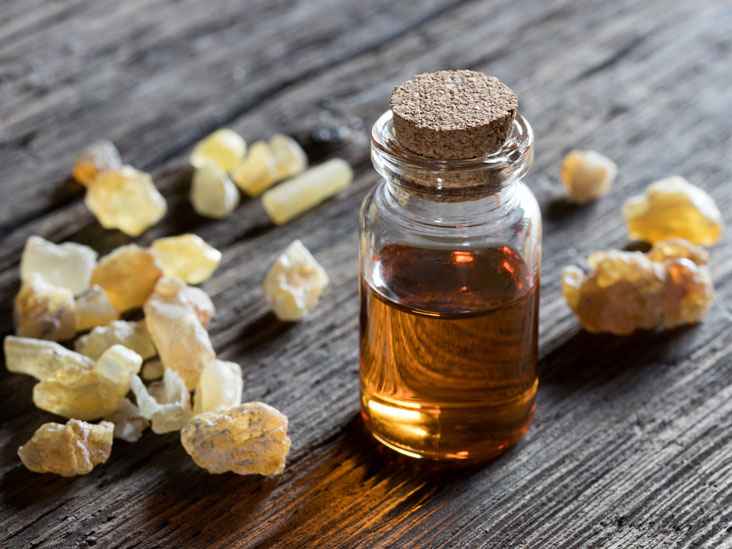 Kurdish obtain Saqqez as edible oil from small wild pistachios trees. They extract from Saqqez fruits by making cuts to them to have herbal gum to chew.
Kurdish obtain Saqqez as edible oil from small wild pistachios trees. They extract from Saqqez fruits by making cuts to them to have herbal gum to chew.
Day 14: Kurdistan, Meaning of beef in Persin Food
Today Persian Food Tour starts by walking inside a mansion from 200 years ago. The mansion shows the Kurdish lifestyle and building decoration in the highland area of Iran. The Khosro Abad mansion’s unique design in the heart of a historical complex shines as an architectural masterpiece.
Then, we drive to Uranamant village to have a spectacular view of a fresh-air landscape. Uranamant is on a slope of the Zagros mountain range hill in deep integration with nature. It shows the distinguishing lifestyle in the western region of Iran. Explore long-aged customs and traditions including culinary art, clothe, and language in the village. Having a workshop on Kurdish dining experience cooking techniques. Finally, let’s taste foods such as Baghali Polow and Ashe Tarkhineh that define Persian cuisine perfectly. Those food flourish our minds about Persian cookery culture. We learn how meat plays an important role in the art of good eating in Iran.
Overnight Kurdistan, (B, L, D).
 Baghali Polow is a luxurious food in Persian culture. Iranians cook it with meat inside of a combination of rice and fava beans dishes.
Baghali Polow is a luxurious food in Persian culture. Iranians cook it with meat inside of a combination of rice and fava beans dishes.
Day 15: Kurdistan-Kermanshah, Surf and Turf in Persian Cuisine
Kermanshah is the second royal Sassanid empire center with a moderate climate. Kurds are the main residents of Kermanshah. They embrace a disparate cultural character of music, folkloric dance, and gastronomy. Kurdish people are the origin of Aryans with ancient customs and traditions. Those customs and traditions are apparent in the Persian food and cuisine of the area.
Our tour starts with an expedition to Palangan village on the way to Kermanshah. We can find unbelievably steep arisen buildings with a distinctive form of architecture. Next to a wild river, we take you out of the harsh modern days to the relaxing atmosphere of a village.
Kermanshah with its unique cuisine gives tourists a memorable Persian food experience. Let’s taste the surf & turf dish of Kermanshah. Barbecue fish and beef with a vary identifying cooking style by having Dandeh Kebab and Mahi Kebab.
Overnight Kermanshah, (B, L, D).
 Dandeh Kebab is a grilled meat kind of kebab. Kurds combine lamb ribs with tomatoes and fresh pepper. They also flavor it with lemon juice and saffron.
Dandeh Kebab is a grilled meat kind of kebab. Kurds combine lamb ribs with tomatoes and fresh pepper. They also flavor it with lemon juice and saffron.
Day 16: Kermanshah, Taste of Persian Food Along History
Today, Persian Food Tour takes us to Behistun historical and cultural complex. It is an outdoor museum from the Paleolithic time to the contemporary era. Behistun depicts a considerable relationship between nature and culture among Kurds. UNESCO registered Behistun as a World Heritage. Behistun indicates one of the most significant archaeological and historical inscriptions in the world. Its multicultural and monarchical remains demonstrate the Greek influence and Sassanid power in Persia. Behistun inscription is a vital legacy to humanity.
Bypassing Behistun, we explore Taq-e Bostan, a complex of Sassanid glories. It embraces rock relief with inscriptions about religious attitudes, music, and rejoicing. Also, shows rock-cut with artistic and historical values about the emperor’s ceremonies and hunting. Taq-e Bostan illustrates the Sassanid empire’s majesty in the northeast part of Kermanshah.
Then, wander at Jameh Mosque of Shafi’i through its unique masterpiece of Peso-Islamic culture. The architecture is an excellent typical Islamic Mosque with a combination of Turkish and Persian architecture. Next in order of time, we will join a confectionary local class to know how Kurds bake Nan-e Berenji. it is a very famous souvenir of Kermanshah. Soon after, we receive a unique Kurdish menu to taste delicious gourmet Persian food.
Overnight Kermanshah, (B, L, D).
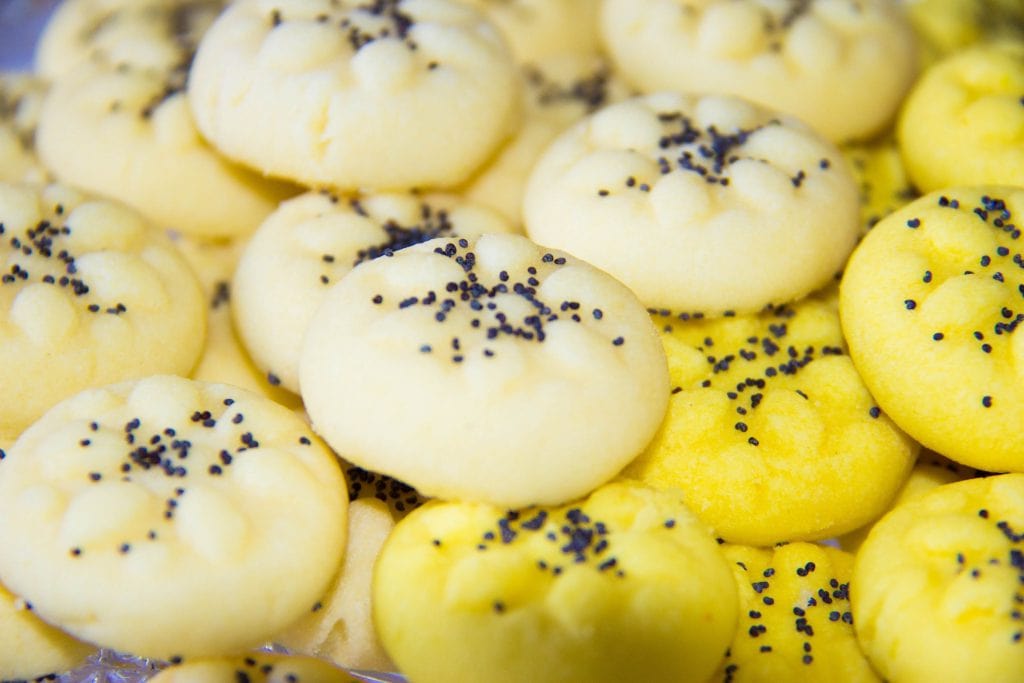
Day 17: Kermanshah-Shiraz, Homeland of Persian History and Snacks
Shiraz is the motherland of Persian culture with all legendary Achaemenids and Sassanids glories. Also, Shiraz is the city of prose & poem, gardens, and flowers. Historical ornaments such as Persepolis and Pasargadae depict history in the city. Shiraz embraces a valuable heritage of Persian food and snacks such as Shirazi Faloodeh.
Touch Incredible Persian Ice Cream
Today, the Persian food Tour starts with Zand dynasty heritages. We visit Karim Khan Citadel which was the residence of Karim Khan King and his family. The structure looks like a castle to guard the royal family and the king. Soon after, we walk to Kolah Farngi Mansion to experience the ceremonial palace of the Zand Dynasty. After that, we taste a mouthwatering saffron ice cream that Shirazi garnishes with pistachio. locals sometimes combine it with Shirazi Faloudeh to feel heaven at the center of Zandie Capital.
Next in order of time, our visits include Vakil Historic Bath, which is an architectural masterpiece in Vakil Complex. Zand Dynasty built it from gypsum, stone, and brick. Then, keep walking to Vakil Mosque to experience a royal holy place. It derives its fame from the art of architecture, calligraphy, and columns engravings. We finish the Vakil complex by visiting Vakil Bazaar. Touch Shirazi nomads and tribes’ clothing and purchase handicrafts in the Bazaar pathways.
Iranian Sherbat (Drinks) Flows Life in Your Vessels
By exploring Vakil Complex, we reach Zinat Al-Molk House. It is a Persian home with a cozy cafe to enjoy evening Persian foods or drinks. The house fascinates visitors with the mirror and woodwork. After a break for lunch, we discover Shirazi cuisine art in a traditional restaurant. Persian Food exploration continues with Eram Garden, the original meaning of Paradise (Pardis in Persian Language). It displays Iran’s peculiar structures in magnificent buildings and botanical gardens. Tourists mostly find the taste of Sherbat interesting in the garden. Finally, we enjoy the relaxing atmosphere of Hafezieh. It is the mausoleum of a poet of love stories, spiritual beliefs, and sagacious poems. His Heritage left an untouched legacy behind for readers to alleviate. Hafez Ghazal by the use of eloquence inspired Persians to fall in love, be honest, and worship Allah.
Overnight Shiraz, (B, L, D).
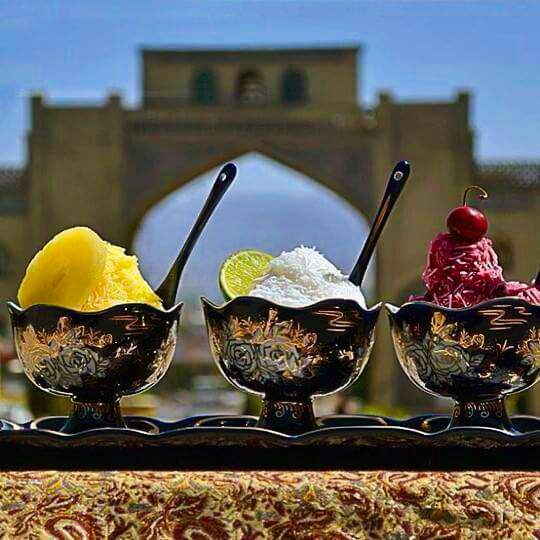 Saffron Ice cream is a Persian traditional kind of summer snack. Iranian garnish it with pistachio and nuts. They serve it with Faloudeh and cherry jam to stir sweet and sour tastes with each other.
Saffron Ice cream is a Persian traditional kind of summer snack. Iranian garnish it with pistachio and nuts. They serve it with Faloudeh and cherry jam to stir sweet and sour tastes with each other.
Day 18: Shiraz, Taste of Imperial Majesties
Persian Food Tour continues with Nasir-ol-Molk mosque. it is a supreme intellectual and artistic sacred place that proves no comparison with a typical mosque. Spirituality lies inside when sunshine passes through the colorful glasses of windows. After that, we travel outside of Shiraz to explore Persepolis (UNESCO Heritage). It is one of the three Achaemenid Empire Capitals for ceremonial events. Persepolis demonstrates the imperial majesty and eminence that Darius the Great constructed. It means ‘city of Persians’.
Then, we visit Naqsh-e Rustam, a Necropolis, where the emperors of Persian civilization tombs are shining in rock cuts. There are kings’ messages that they engraved on rock reliefs. Also, the Zoroastrians’ sacred place “ Cube of Zoroaster ” is a spiritual monument there. Next in the itinerary, we take a short walk to Naqsh-e Rajab. It is an open-air archaeological archive. Naqsh-e Rajab displays Sassanid imperial impregnable power and triumphs over the Roman emperor. Now, it is time to have a better understanding of Persian Food culture.
Let’s satisfy our curiosity about Persian food art and the science of good eating with a cooking workshop. Also, good to know that Shiraz is the city of famous Salads such as Shirazi Salad. Then, on the way back downtown we have a glance at Quran Gate. It is the entrance gate of Shiraz from the north. Zand dynasty built the gate in reason of blessing passengers with the holiness of the Quran. Finally, we go to Sa’diyeh, the mausoleum of a poet who nourishes you with words and wisdom. Sa’adi with his global reputation for verses left us with the most valuable books such as GOLESTAN & BOSTAN.
Overnight Shiraz, (B, L, D).
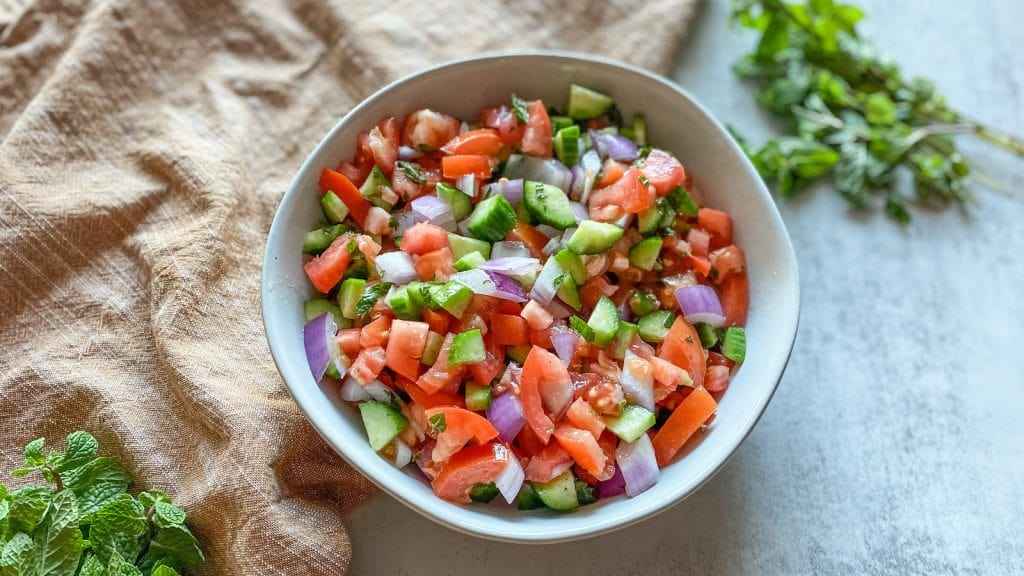 Shirazi salad is famous salad among Persians. It is a delicious combination of onion, tomato, and cucumber. Locals flavour it with pepper and lemon juice.
Shirazi salad is famous salad among Persians. It is a delicious combination of onion, tomato, and cucumber. Locals flavour it with pepper and lemon juice.
Day 19: Shiraz-Isfahan, Route of Ruck Cuts and Handicrafts
Today, we embark on a full-day journey to Isfahan by having a deep expedition to Pasargadae. It is the ancient capital of Achaemenid. Cyrus the Great built it as a famous fourfold Persian model of the garden. Pasargadae (UNESCO Heritage) explains the nobility of Cyrus the Great and his necropolis. Continuing Persian Food Tour, we visit a Global City of Wood-carvings. We discover a very skillful art that the Iranian call Monabatkari or Moghaarkari. Professionals replete woods with religious designs or flower motifs. Then, we will have an expedition to the Izad Khast Complex. It is an adobe structure from the Sassanid empire. The adobe includes a fortress, fire temple, caravansary, bathroom, and the city of Izad Khast.
Overnight Isfahan, (B, L, D).
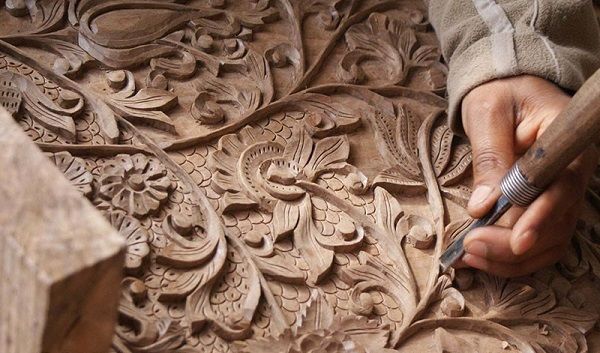
Isfahan, Land of Cosy Restaurant and Persian Food
Isfahan (Crafts and Folk Art UNESCO Creative City) is a city of glories and Perso-Islamic masterpieces. The city is the craftsman’s home as a center of art. Isfahan is a gallery of art, architecture, and handicrafts. Also, Isfahan shines in urban structures and music among the cities in the world. The city is a treasure of mosques, cathedrals, mansions, bridges, and gardens. Isfahan is a city of traditional and modern restaurants with delicious traditional Persian food. The restaurant recipes surprise you with the taste and ingredients. Shahrzad restaurant is one of those that is an art rather than a place to eat.
City of UNESCO Heritage and Architecture
Persian Food Tour begins with a three-floor building in Isfahan. It is Qeisarie Gate in remembrance of the king as the main entrance to Isfahan Grand Bazaar. The gate directs us to Naqsh-e Jahan Square (UNESCO Heritage). We will have a workshop on the art of Minakari. It demonstrates how Iranians enameled objects to place heaven into decorating metal. They use mostly Silver and Copper or tile with patterns and paintings.
Next in order of time, we walk to Sheikh Lotf Allah Mosque (UNESCO Heritage). It shows the genius interior and exterior decoration of the dome. The mosque was a royal mosque for Shah Abbas Safavid. After that, we visit the Shah Mosque, which depicts Persian architecture in the Islamic era. It consists of iwans, domes, tilling, and supreme engineering of voice echoing. Finally, our trip to the square will end at Ali Qapu Palace (UNESCO Heritage). It is a gallery of art in terms of music, painting, and decoration in an acoustic structure.
Persian Food Tour continues with Chehel Sotun Garden (UNESCO Heritage). It is a relaxing atmosphere with gorgeous paintings. Then, we travel to the white river to indulge ourselves in the beauty of the worldly known Khaju and Si-o Se Pol Bridges.
Overnight Isfahan, (B, L, D).
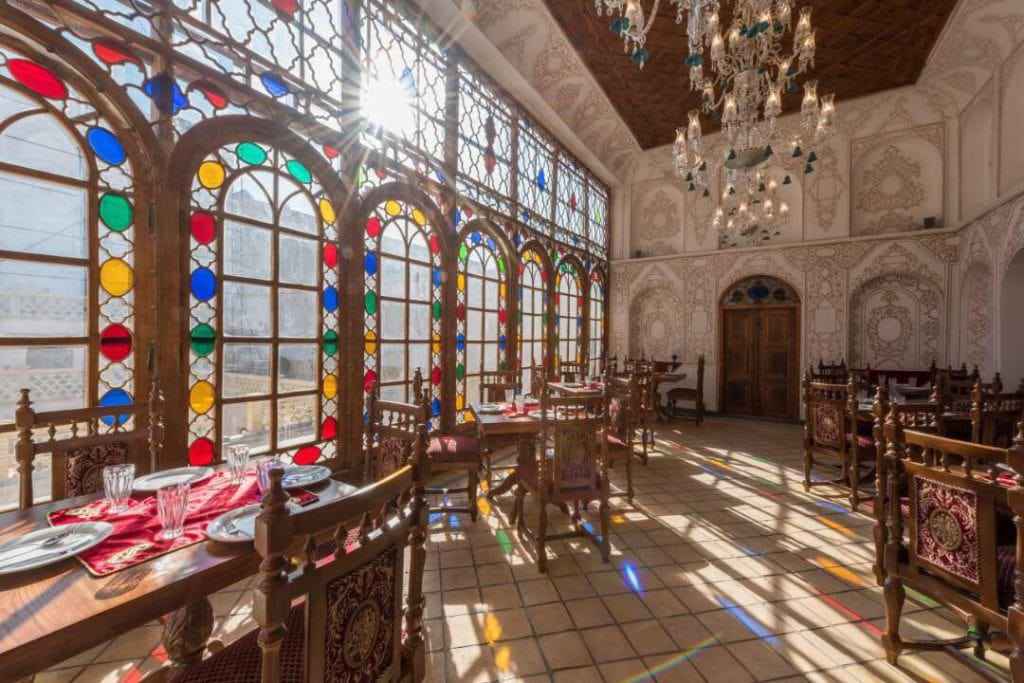
Day 21: Isfahan, City of Snacks
The Persian Food tour starts with Vank Cathedral and its fascinating paintings and mosque-like dome. Soon after, we walk to Armenian Genocide Museum to have a glance at the historic handwritten books. It includes artifacts of the cathedral and the first printed book in Iran. After that, we travel to Isfahan Jame Mosque (UNESCO Heritage). It is one of the oldest ones in Iran.
Now, it’s time to have a delicious evening Iranian meal in an old and popular pastry spot in Isfahan. Doogh and Gooshfil is a tasty local Persian meal that Isfahani people serve. Our exploration continues to Chahar Bagh Street which is a masterpiece of urbanism. Also, we visit Hasht Behesht Palace while walking along the street. It was a royal pavilion with glamorous paintings, woodwork, mirrorwork, and tilling. Finally, we travel to the white river to see the beauty of the Si-o-Se Pol Bridge.
Persian Food Trip takes us into another aspect of Iranian cuisine culture. Snacks play an important role in Persian daily life. Especially, the ones Isfahani residents historically produce. Tourists are always thirsty for Isfahani snacks such as Gaz, Sohan, and Polaki. Locals mostly flavor those Persian snacks with saffron and garnish with pistachio. Though, the evening snack workshop demonstrates how locals kept such a tradition of cooking art.
Overnight Isfahan, (B, L, D).
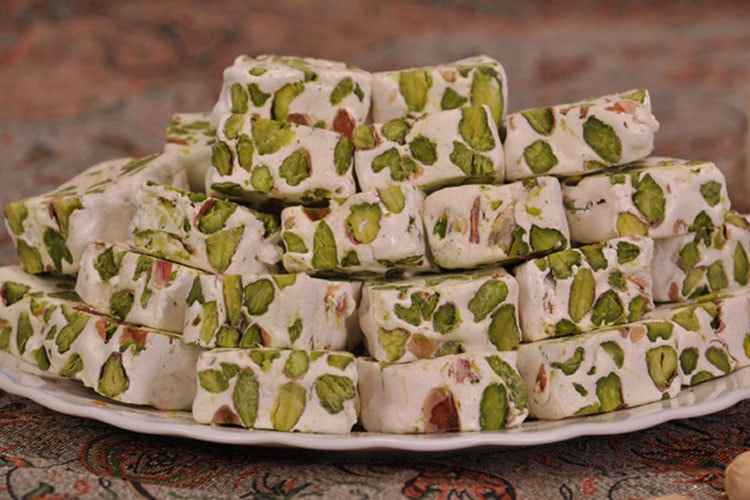
Day 22: Isfahan-Kashan, Experience Persian Food Along Desert
On the way from Isfahan to Kashan, we have an expedition to Abyaneh village. It is one of the ancient rural areas in Iran. Abyaneh village shows us historical traditions and customs including distinctive buildings. Also, we experience a very unique cooking show in such an atmosphere. It lets us understand desert cuisine in Persian food culture. Then, we travel to Kashan which is one of the homelands of human civilization. Kashan perfects our knowledge about the country on the last night of the Persian Food Tour.
First, we travel to Fin Garden (UNESCO Heritage), which depicts a genuine Persian garden. Then, we visit Aminodole Caravanserai at the center of Kashan Bazaar. It is a coherent form of structure that reflects hospitality in Iran. Finally, we visit Agha Bozorg Mosque. It is the only one in its model as a mosque with a sunken courtyard.
Overnight Isfahan, (B, L, D).
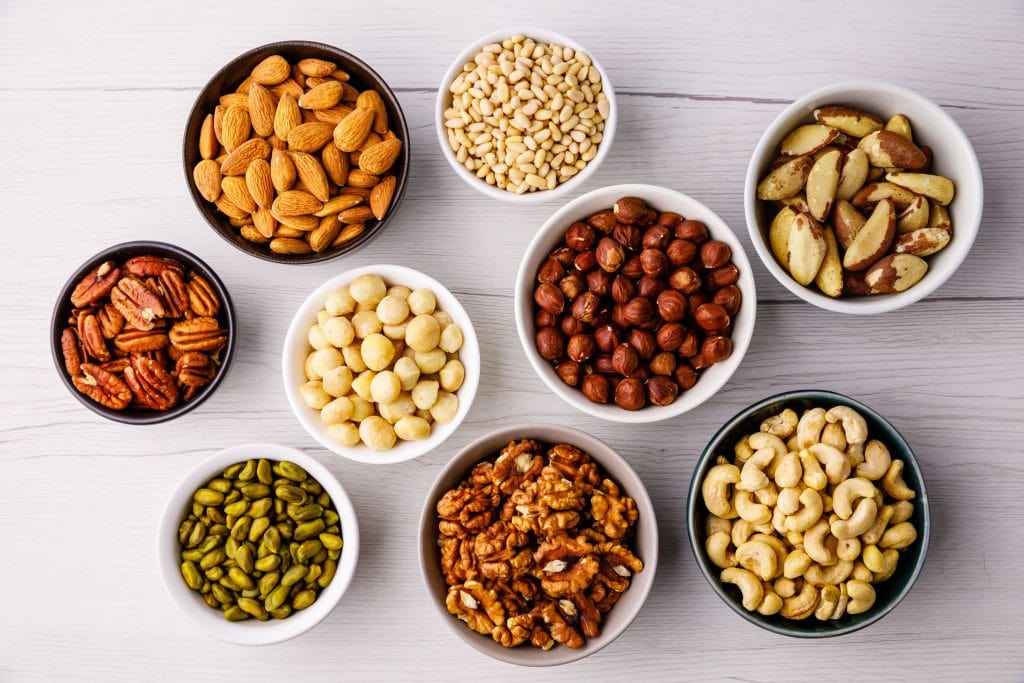
Day 23: Kashan, Land of Rosa Water and Persian Coffee
The last day of the Persian Food Tour takes us to Kashan Legacies. It begins with Boroujerdi House. The house shows the desert style of wind-catchers with Persian traditional models of iwan. Boroujerdi House embraces superb plasterwork in interior and exterior decoration. Soon after, we visit Sultan Amir Ahmad’s Bathhouse to feel Persian gatherings meanwhile bathing. Finally, we smell Persian coffee as Kashan is one of the centers for such hot drinks in Iran. In the end, we drive to the IKA Airport to Depart Iran.
Kashan produces the most smelling rosa water in the world. Iranian use it for cookery art and as a healing drinks. Also, Muslim wash Kaaba with Kashan Rosa Water every year.
